Snake Behavior and Life History


| These are pictures and videos that illustrate some of the interesting behavior and or natural history of snakes from California and around the world. This is not an attempt to illustrate everything, only what is depicted elsewhere on this website. |
|||
| Miscellaneous Snake Observations | |||
 |
 |
 |
 |
| This dead juvenile Pacific Gophersnake was found in Sutter County. It appears to have a leg, but on closer inspection, it is the leg of what is probably an alligator lizard that broke through the snake's side after the snake swallowed it. © Kevin Bryant |
Some snakes can climb up walls, especially when they can use an inside corner and a rough-texture to give them a grip. This San Diego Gophersnake was observed crawling up the stucco wall next to the front door on the outside of a house in Riverside County. © Gary Sopata | Most snakes are good swimmers and good climbers. This Green Ratsnake is climbing straight up the bark of a tree. |
Rattlesnakes are often depicted in fiction as aggressors, leaping and striking viciously, often for no reason other than to give the hero an excuse to kill it to prove himself. The truth is that rattlesnakes are almost always defensive, not offensive, when they encounter humans, wanting nothing more than to escape, and the least heroic thing someone can do is to automatically kill them. The Northern Pacific Rattlesnake in this video is seen slowly following a snake hook with curiosity, not aggression. The hook had been used earlier to pick up a breeding pair of snakes, and we decided that this one was probably a male that smelled the scent of the breeding female on the hook. |
 |
 |
 |

Click on this picture to see an illustrated interpretation of the various ways pit vipers (including rattlesnakes) perceive their prey, using their eyes, their sense of smell, their ability to detect vibrations, and their ability to sense heat. © Frank Buchter |
| This video shows how a snake uses its long forked tongue to sense its surroundings. (The snake shown here is a San Diego Gophersnake.) |
This juvenile Northern Mohave Rattlesnake was spotted resting, avoiding the daytime heat, inside a small animal burrow under a desert shrub. | A predator becomes the prey. Sort of... A Ventura County San Diego Alligator Lizard bites onto the nose of a predatory California Striped Racer, leaving the snake unable to strike. Eventually the lizard released its grip and the two ran in opposite directions. © Melissa Wantz |
|
 |
 |
 |
 |
| Sometimes snakes seem to come almost out of nowhere - because sometimes they really do. This adult Red Racer was photographed for about 20 minutes as it poked its head in and out then slowly emerged from a hole barely larger than itself in San Diego County © Douglas Brown | |||
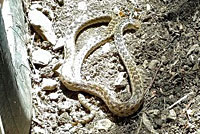 |
 |
 |
 |
| This short video shows a Gophersnake digging earth by curving its head and using the curve to scoop up and move the dirt. The reason for its digging is uncertain. Three Gophersnakes were seen in and outside a hole. The photographer carried them to a nearby field then blocked the hole with a stone. The snake seen here returned near the stone and tried to dig its way back into the hole. My guess is that since this occurred in the April breeding season, one of the snakes was a breeding condition female who entered the hole for some reason and that the other two snakes were males attempting to mate with her. The snake seen here is probably a male attracted to her scent. | This wild juvenile San Diego Gophersnake has two heads. Two-headed snakes are rare, but they show up occasionally in captive breeding and in the wild. |
||
 |
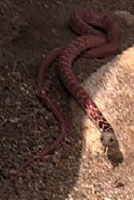 |
 |
|
| Many species of snakes can quickly climb high up a tree. This California Striped Racer was photographed high up a tree in Santa Barbara County. © Francesca Heras | I saw the Red Racer in this video crawling around before it saw me. After turning around to move towards me, it became aware of me, raised its head off the ground in a state of alert, and wiggled its neck back and forth rapidly, while holding its head still, then turned around and raced away over the rocks into a bush. I don't know what the neck movement was about, but maybe it was meant to make the snake look more threatening. | Racers and whipsnakes, like this Western Yellow-bellied Racer, sometimes "periscope" raising their head up high to get a better view in tall grass. © Ryan Sikola | |
| Snake Dens (Hibernacula) and Aggregations | |||
 |
 |
 |
 |
 |
 |
 |
 |
| The four pictures on top and the four videos directly above show thousands of Red-sided Gartersnakes in their spring mass emergence from hibernation, as they wrestle for breeding opportunities in the Narcisse snake dens in Manitoba, Canada. | |||
 |
 |
 |
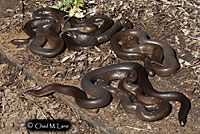 |
| Great Basin Rattlesnakes have been seen for at least 20 years at this den site in Nevada. It is important not to give out the location of rattlesnake den sites indiscriminately, because the snakes are vulnerable to attack or over-collection when they are gathered around the den. © Tom Green - TomGreenPhotography.com | Group of adult Rubber Boas, Marin County © Chad Lane In winter, it is not uncommon for several snakes, including multiple species, to share the same shelter. 8 boas were found under the same board along with a few Coast Gartersnakes. |
||
 |
 |
 |
 |
| Northern Pacific Rattlesnake den site, Contra Costa County © Erik Grouell | Southern Pacific Rattlesnake den habitat, Los Angeles County © Koby Poulton |
A deep crack in a large boulder serves as the entrance to a Northern Pacific Rattlesnake den in Kern County. A rattlesnake basks at the bottom right of the crack. Deep cracks like this often harbor several species of snakes and even San Diego Alligator Lizards during the winter. | |
 |
 |
 |
 |
| During winter, many snakes stay underground or deep in rock cracks, where the temperature is warmer than it is outside. They do not eat or move around much during this time. Some snakes overwinter in large groups. The snake dens in Narcisse, Maitoba, Canada are a well-known tourist attraction. In this picture you can see a mass of Wandering Gartersnakes and Valley Gartersnakes after emergence from their winter den in Wyoming in early May. © Leslie Schreiber | Northern Pacific Rattlesnake basking in March, San Joaquin County | Northern Pacific Rattlesnakes at hibernaculum, Humboldt County © Lee Hecker |
Northern Pacific Rattlesnakes at hibernaculum, Humboldt County © Lee Hecker |
 |
 |
 |
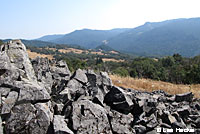 |
| Northern Pacific Rattlesnake hibernaculum, Humboldt County © Lee Hecker |
Northern Pacific Rattlesnake hibernaculum, Humboldt County © Lee Hecker |
Northern Pacific Rattlesnake hibernaculum, Humboldt County © Lee Hecker |
Northern Pacific Rattlesnake hibernaculum, Humboldt County © Lee Hecker |
 |
 |
 |
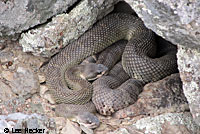 |
| Northern Pacific Rattlesnake hibernaculum, Humboldt County © Lee Hecker |
Northern Pacific Rattlesnakes at hibernaculum, Humboldt County © Lee Hecker |
Northern Pacific Rattlesnakes at hibernaculum, Humboldt County © Lee Hecker |
Northern Pacific Rattlesnakes at hibernaculum, Humboldt County © Lee Hecker |
 |
 |
 |
 |
| Northern Pacific Rattlesnakes at hibernaculum, Humboldt County © Lee Hecker |
Northern Pacific Rattlesnakes at hibernaculum, Humboldt County © Lee Hecker |
Northern Pacific Rattlesnake at hibernaculum, Humboldt County © Lee Hecker |
Northern Pacific Rattlesnake at hibernaculum, Humboldt County © Lee Hecker |
 |
 |
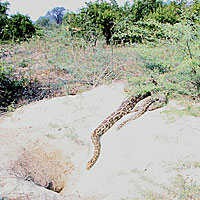 |
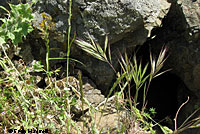 |
| During the winter in the northern Indian state of Rajasthan, when it can get very cold and foggy, Indian Pythons retreat underground into large porcupine burrows. When the sun emerges on winter afternoons, they often move up to the mouth of the burrow to warm up in the sun, as seen here. They also emerge completely from the hole and bask in the sunlight with their bodies stretched out near the mouth of the burrow. |
In winter, Indian Rock Pythons take advantage of sunny days to bask outside their hibernacula. When threatened, they simply crawl or slide quickly into the hole. These were two of several pythons seen basking and retreating into this hole in January in Rajasthan, India. | Juvenile basking outside hibernaculum in Alameda County © Emily Mastrelli | |
| Polymorphism | |||
Animals that are polymorphic come in a variety of patterns and colors. Often young from the same clutch all have a difference appearance. |
|||
 |
 |
 |
 |
 |
 |
 |
 |
 |
 |
 |
 |
| © William Flaxington |
© Alan Barron | © Alan Barron | © Jeremiah Easter |
| The Northwestern Gartersnake - Thamnophis ordinoides, is polymorphic. Notice the wide range of colors, patterns, and number of stripes on the snakes above. They are not all from the same location, but they are all the same species. (At one time they were considered to be several different species due to their differences in appearance.) Studies have shown that the escape behavior of this snake is determined by pattern: striped snakes will escape by crawling away, since the stripes make it difficult to determine the snake's speed, while spotted or plain snakes will crawl, suddenly change direction, then hold still, as their pattern tends to blend in with the background. (E. D. Brodie III) |
|||
 |
 |
 |
 |
 |
 |
 |
|
| Variable Groundsnakes are also polymorphic, coming in a variety of banded, striped, and plain patterns. | |||
| Snake Movement | |||
 |
 |
 |
 |
| This video shows the sidewinding locomotion of a Mohave Desert Sidewinder. | This video shows the slow, deliberate movement of a Red-diamond Rattlesnake as it crawls across rocks and ground in the desert at night. At one point, it continually raises up as if it is attempting to crawl higher, but it is on top of the boulder with nowhere to go. | This video shows a large San Diego Gophersnake moving quickly, keeping its body nearly straight. |
This video shows the rapid movement of a long, thin San Joaquin Coachwhip. |
 |
 |
||
| A Colorado Desert Sidewinder found on a road at night rattles and sidewinds. | This video shows the rapid "Lateral Progression" movement of a Mohave Shovel-nosed Snake. |
||
| Snakes Swimming | |||
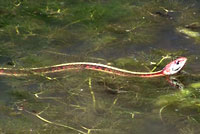 |
 |
 |
 |
| Video: A red-sided gartersnake swims around in a small cattle pond on a sunny spring afternoon in Alameda County. I wanted to get a closer look, so I walked over to the snake's side of the pond, but then it swam to the other side, again and again, until I got tired of going round in circles. | Most snakes can swim. Some species spend much of their time in the water hunting for frogs and fish. This video shows Oregon Gartersnakes basking and swimming. | California Kingsnake swimming across a stream © Nicholas Hess | Video: Diablo Range Gartersnakes swimming in another cattle pond in Contra Costa County. |
 |
 |
 |
 |
| Giant Gartersnake observed in an agricultural conduit, Sacramento County | Video: A Sierra Gartersnake crawls and swims in a Tuolumne County lake. | This adult Sierra Gartersnake saw a brown trout rising in a creek in
El Dorado County, raced across the creek, grabbed the trout, and dragged it to the shore. © Gary Ridley |
Video: Watersnakes (Nerodia) spend most of their time in the water, like this Northern Watersnake |
 |
 |
 |
 |
| Gartersnakes are often seen in water, like this Diablo Range Gartersnake | Swimming Santa Cruz Gartersnake © Scott Peden |
I watched this Sonoran Gophersnake swim across a narrow part of the Colorado River from Arizona to California. |
A Southern Watersnake swims across a lake in Los Angeles County. |
 |
 |
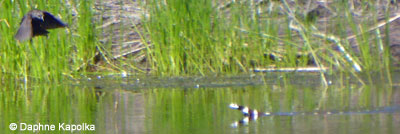 |
|
| This large adult Pacific Gophersnake was seen swimming on a lake in Sacramento County. |
A California Kingsnake swims in a pond where it was harassed by a pair of red-winged blackbirds, probably because they feared it was looking for a nest to raid. © Daphne Kapolka |
||
| Skin Shedding | |||
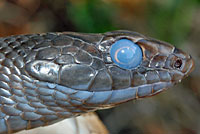 |
 |
 |
 |
| The milky eye of this Eastern Coachwhip, which is close to shedding its skin, shows why snakes in this pre-shed condition are called "blue" or "in the blue." | This Western Yellow-bellied Racer is about to shed its skin, which you can tell by the milky eye. |
This juvenile Western Yellow-bellied Racer shows the milky eye of a snake about to shed its skin. © Joel A. Germond | |
 |
 |
 |
 |
| This California Kingsnake shows the milky eye of a snake about to shed its skin. | Two-striped Gartersnake preparing to shed, with milky eyes. | Snakes start shedding their skin at the tip of the nose, as you can see on this Puget Sound Gartersnake that is just beginning to shed its skin. © Filip Tkaczyk |
This juvenile Northern Pacific Rattlesnake was found under a rock next to its recently shed skin. © Luke Talltree |
 |
 |
 |
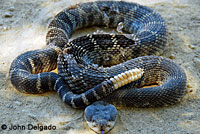 |
Adult Southern Pacific Rattlesnake |
This adult Northern Pacific Rattlesnake is shedding its skin. © John Delgado | ||
 |
 |
 |
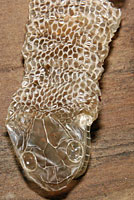 |
| All of these shed snakeskins were found in the field. Sometimes you don't find snakes, but you know they're around because you find their shed skins. | |||
| Snake Tracks and Other Signs of their Presence | |||
 |
 |
 |
 |
| Something big crossed here... | California Kingsnake Tracks | San Diego Gophersnake Tracks | Southern Pacific Rattlesnake Tracks |
 |
 |
 |
 |
| Mojave Sidewinder Tracks | San Diego Gophersnake Tracks | A big Coachwhip quickly crossed here just before I took this picture. | Patch-nosed Snake Tracks |
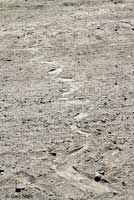 |
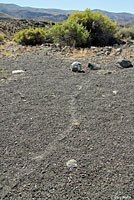 |
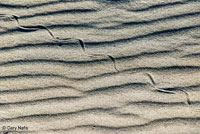 |
 |
| Western Yellow-bellied Racer Tracks | Something big crawled through here... | Shovel-nosed Snake Tracks | Could have been a Gophersnake... |
 |
 |
 |
 |
| A Colorado Desert sidewinder crawls over a sand dune showing its characteristic tracks. © Jason Jones | Shed snake skin | Ground Snake shed skin | Ground Snake shed skin |
 |
 |
||
| Garter Snake shed skin | Shed of unknown species, Rio Grande Valley, Texas. |
||
| Snake Predation | |||
 |
 |
 |
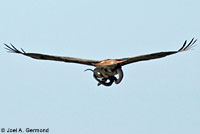 |
| A California Kingsnake killing a Pacific Gophersnake for dinner in Contra Costa County. © Tim Dayton |
Snakes are sometimes preyed upon by birds of prey, or raptors. Here, a San Diego Gophersnake is carried off by a Red-tailed Hawk in San Luis Obispo County. © Joel A. Germond |
||
 |
 |
 |
 |
| California Kingsnakes are powerful predators capable of eating other snakes almost as large as they are. Here you can see one eating a Pacific Gophersnake. © Patrick Brigg |
The results of red-tailed hawk predation on a California Kingsnake, Riverside County © Jeff Ahrens |
Lonnie Fehr discovered this adult California Striped Racer cannibalizing a juvenile racer in the San Gabriel Mountains of Los Angeles County. | |
 |
 |
 |
 |
| California Kingsnakes eat snakes along with other animals. They are immune to rattlesnake venom, so they sometimes eat rattlesnakes. This one is eating a juvenile Southern Pacific Rattlesnake. © Kimberly Deutsch |
This California Kingsnake is almost finished eating a juvenile Northern Pacific Rattlesnake. © Michele Coughlin | ||
 |
 |
 |
 |
| A California Striped Racer - Coluber lateralis lateralis, eating a juvenile Southern Pacific Rattlesnake in Los Angeles County. © Anthony |
This Sierra Mountain Kingsnake is eating a juvenile Northern Pacific Rattlesnake, © Patrick Briggs |
||
 |
 |
 |
 |
| A California Kingsnake eating a Southern Pacific Rattlesnake in Orange County © Ed Smith | |||
 |
 |
 |
|
 |
 |
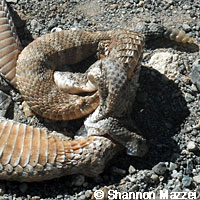 |
|
| Stacy Holt with Death Valley National Park sent me the above six photos which were taken on 8/28/13 by National Park Service Employees Drew Kaiser and Shannon Mazzei. Drew and Shannon saw the snakes struggling at around 11 AM in near Towne Pass. A California Kingsnake was wrapped tightly around a Panamint Rattlesnake and the snakes were barely moving. Disturbed by the onlookers, the kingsnake retreated under a nearby bush. The rattlesnake was dead by that time, and appears to be biting itself, but was described as biting onto the kingsnake before it died. The kingsnake probably returned to swallow the rattlesnake after the people left. You can see other interesting wildlife sightings on the Death Valley National Park Facebook Page. |
|||
 |
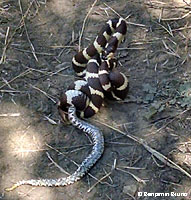 |
 |
 |
| This California Kingsnake was discovered eating a juvenile Southern Pacific Rattlesnake in the Los Padres Mountains, Santa Barbara County © Benjamin Bruno | Chad M. Lane found this adult Long-nosed Snake in Alameda County eating another adult Long-nosed Snake. A report of the sighting was published in Herp Review in 2009 as the first documented occurrance of cannibalistic behavior in this species. © Chad M. Lane | ||
 |
 |
 |
 |
| A California Striped Racer eats a Coast Patch-nosed Snake in Los Angeles County, near Altadena. © David Couch | A Red Racer eats a juvenile Southern Pacific Rattlesnake in Riverside County © Steven Elliott | American Bullfrogs are voracious eaters that can impact native species, including threatened species like this Arroyo Toad and this Two-striped Gartersnake, which were found in the belly of a large adult bullfrog in San Diego County.The snake was dead, but the toad was alive. When put back in the creek, it hopped away. A Bullfrog eradication project is now underway at the site where this was photographed. © Andrew Borcher Animals captured and handled under authorization by the California Department of Fish and Wildlife. |
|
 |
 |
 |
 |
| This Cooper's Hawk was observed flying out of a bush carrying an adult Pacific Gophersnake up to a roof in Monterey County. © Wim de Groot | An adult Pacific Gophersnake captured by a Red-tailed Hawk near the ocean in Monterey County. © Diederick de Groot | An adult Pacific Gophersnake captured by a Red-tailed Hawk flying near the ocean in Monterey County. © Wim de Groot | |
 |
 |
 |
|
| Adult Red Racer eating a juvenile Northern Mohave Rattlesnake, San Bernardino County © Yvette Watson | Red Coachwhips will eat whatever they can find and overpower, including snakes. Darrel Roberts found this one eating a young Southwestern Speckled Rattlesnake in his Phoenix driveway one morning. © Darrel Roberts | ||
 |
 |
 |
|
| A juvenile Red-tailed Hawk with a freshly-killed San Diego Gophersnake in coastal San Luis Obispo County. © Joel A. Germond |
A California Kingsnake eating a Pacific Gophersnake in Santa Clara County © Faris K |
This Red Racer became prey to a red-shouldered hawk in San Diego County. © Dennis Rudloff |
|
 |
 |
||
| This formerly-endangered Santa Cruz Island Fox was discovered preying on an adult Santa Cruz Island Gophersnake on Santa Cruz Island, Santa Barbara County. The fox dropped the snake when it saw that it was being watched but it returned later to carry the snake away. © Kay Fuhrmann | |||
| Human Use of Snakes | |||
 |
 |
 |
 |
| Rattlesnake rattles attached to fiber cord, Chamacoco, (South America) American Museum of Natural History |
Life-sized deer made of the rattles of 657 large rattlesnakes, Buckhorn Curio Museum, San Antonio, Texas | Rattlesnake rattle art, Buckhorn Curio Museum, San Antonio, Texas | Snakes were used to make "snake oil" that promised to cure pains, strains, sprains, bruises, sore feet, stiff joints, sore muscles, and other ailments. |
 |
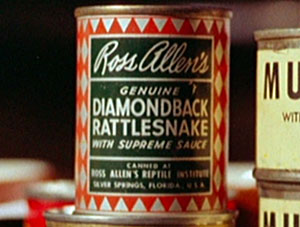 |
 |
 |
| Humans around the world eat snakes, including canned rattlesnake meat. © Lou Silva |
Canned rattlesnake meat. | The documentary "Mondo Cane" released in 1962 includes a segment filmed in a market in Singapore (where we are told that snake is the national dish) that shows a woman shopping for snake meat and a snake being cooked and eaten in an outdoor restaurant. | This fictional movie includes a scene in a real snake market in Hong Kong where we see a snake skinned alive, chopped up, cooked, and eaten. |
 |
 |
||
| Shoes and purses made of python skin on display for sale in a store in Bangkok in the early 1990s. Besides these items, snake skin is often used in belts, boots, jackets, and even hat bands. I've seen hatbands made of rattlesnake skin with the rattle and an open-mouthed rattlesnake head. (Do a Google Image Search for "snake hat band.") At a prairie dog town tourist trap in Kansas on the highway that I stopped at in the mid 1980s, there was a huge pit full of prairie rattlesnakes and many items made of rattlesnakes for sale in the store, including clear plastic toilet seats with rattlesnake heads and rattles inside the seat! |
Python skin hand drum, museum display, Mumbai, India | ||
Return to the Top
© 2000 -
